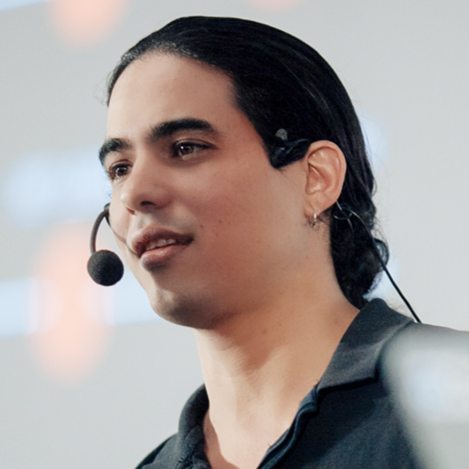
Introduction
Nir Kaufman has been in the tech industry for over 20 years, with a career spanning frontend development, community building, and global conference speaking. This October, he joins Frontmania as keynote speaker and bootcamp trainer.
In this conversation, Nir shares why he believes not every product needs AI, what prompt engineering really means, and how developers can build safe, reliable AI applications.
What are the key points participants will take away from your bootcamp?
Nir: The first big one is understanding the difference between prompt design and prompt engineering. Prompt design is what anyone does when they open ChatGPT and type: “Write me an article.” Prompt engineering is what developers do: writing structured prompts that aim for accuracy, performance, and cost efficiency.
I like to compare it to SQL. Most developers can write a query that works, but only specialists know how to make it efficient and production-ready. Prompt engineering is the same — it’s not just casual prompting, it’s a skill that takes practice.
Does every app really need AI?
Nir: Absolutely not. We’re in the middle of a hype cycle, and a lot of companies are rushing to add AI just because they think they have to. The real question isn’t “Does it have AI?” but “Would a language model actually make the user experience better?”
LLMs are powerful because they understand natural language. That can improve almost any system with human interaction — but it doesn’t mean every product should force it in. Sometimes the simplest solution is still the right one.
Should developers be worried about AI replacing them?
Nir: Not at all. Think about tractors, they didn’t replace farmers, they just made them more productive. AI is the same. It won’t replace experienced developers. In fact, it makes good engineers even more valuable, because someone still needs to know how to build reliable systems with it.
The group I do worry about are juniors. Many are skipping fundamentals and relying too much on AI tools. Without that foundation, it’s going to be harder for them to grow into strong engineers.
You’ve written about the Full-Stack AI Engineer. What does that role mean?
Nir: The industry has evolved a lot. We started as software developers, then frontend and backend, then full stack. Now we’re seeing the rise of the full-stack AI engineer: someone who builds across the stack and also integrates language models.
It’s not a replacement, it’s just the next step. Frontend developers in particular are in a great position because they already understand user interaction — and LLMs are changing how people interact with software.
What changes should frontend developers expect with LLMs?
Nir: Natural language is becoming the new user interface. Instead of endless forms, menus, and filters, users will just describe what they want and get it.
Take booking.com. Right now you enter dates, budget, filters. With an LLM, you could just type: “I’m going to Amsterdam, three nights, budget €500” and that’s it. The system brings you the result directly.
That shift changes frontend architecture. Fewer pages, fewer routes, more generative UI components streamed on demand. It’s exciting because it feels like we’re going back to true single-page applications, but with a new twist.
LLMs are often described as “black boxes.” How should developers debug and evaluate them?
Nir: You can’t unit test an LLM like you do with traditional code. Instead, you need to look at the outputs, group test cases, measure consistency, and refine from there.
And prompt engineering plays a big role here too. A well-crafted prompt can not only improve accuracy but also save thousands of tokens — which means saving money.
Can you explain RAG and why it matters for developers?
Nir: One thing that often surprises developers is that LLMs don’t actually have memory. They process the input you give them and return an answer, but they don’t remember anything beyond that. If you want persistence or context, you have to build it yourself.
That’s where RAG, “Retrieval Augmented Generation” comes in. Instead of expecting the model to “remember,” you fetch the relevant information from a trusted dataset and attach it to the prompt at runtime. That way the system feels smarter, stays accurate, and reduces hallucinations.
But there’s a trade-off. Every token you send to the model costs money. So developers need to think carefully: when is it enough to save chat history in a simple NoSQL database, and when do you need a vector store to enable semantic or similarity search? These choices are part of the new architecture we all have to learn.
Does AI risk making us less creative in the long run?
Nir: I don’t think so. Think of calculators, they didn’t kill mathematics. They just made us more efficient. Or cars, they made life easier but also created new challenges.
AI is similar. It won’t replace creativity for creative people. If your mind is already wired to come up with ideas, AI just helps you bring them to life faster. But if you never practice creativity, AI won’t magically turn you into an artist or a developer. The real opportunity is combining human imagination with these new tools.
Final Question: You’ve been active in tech communities for more than a decade. Why is this important to you?
Nir: Honestly, it’s curiosity and fun. I’m very technical, but I also really believe in people. Communities are where you learn from others, share experiences, and grow together.
Looking back, my career has been shaped just as much by conversations at conferences as by the code I’ve written. That’s why I never miss a chance to connect. For me, technology is exciting but it’s the people that make the journey worthwhile.
